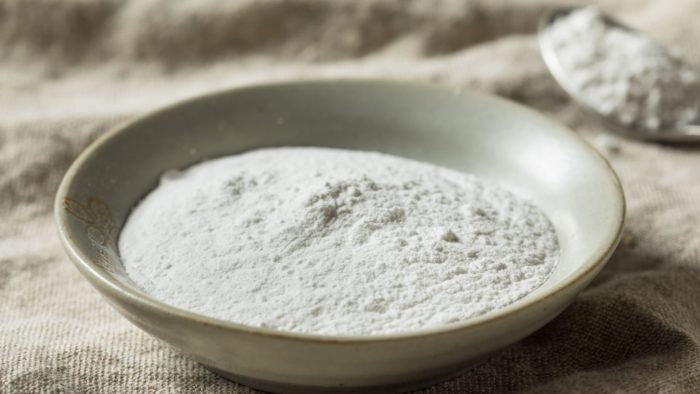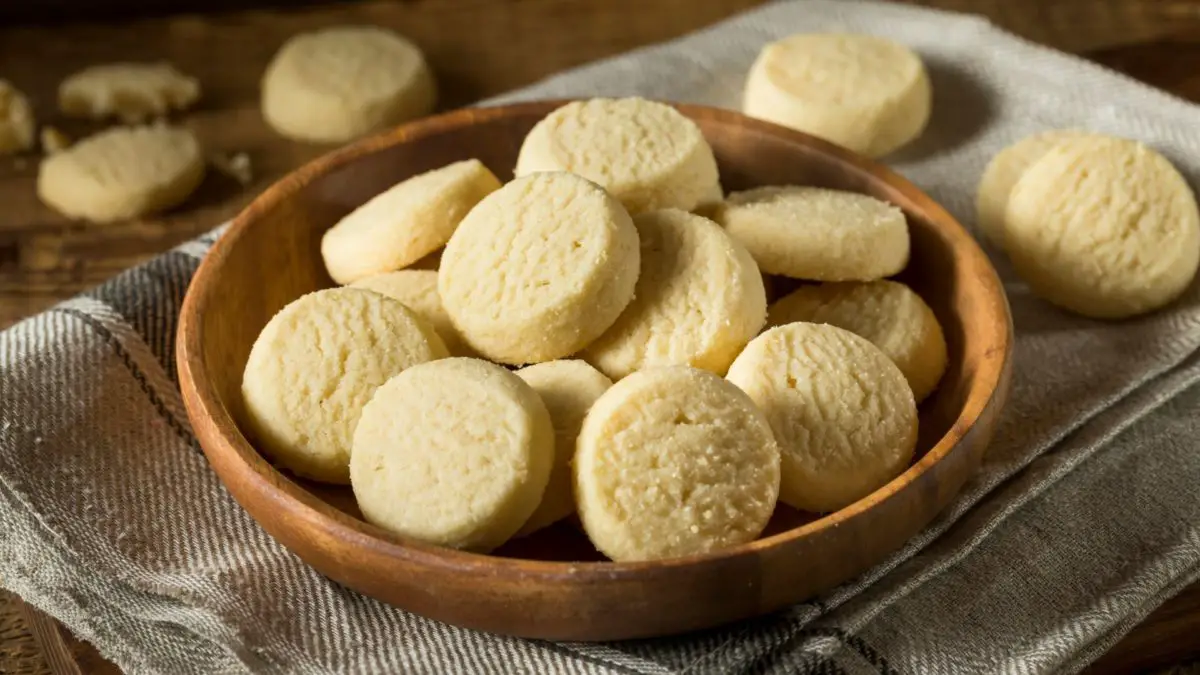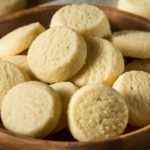Last Updated on February 5, 2023
Have you ever wondered “what does cream of tartar do in cookies?”. If you were planning on leaving it out, you may want to read this informative article.
Cream of tartar is an essential, yet underrated, an ingredient in the kitchen. It has many important functions, yet people think they can just skip over it. Unfortunately, leaving it out of your recipe could lead to the cookie being flat, dense, and flavorless. So, read on to learn exactly what this amazing ingredient does.
What is Cream of Tartar?
Cream of tartar is one of those ingredients that all bakers have, but few actually know what it is or why we use it. And, to properly understand the answer to the question “Why is there cream of tartar in cookies?” you need to know what it is, what it does, and how to effectively use it.
Cream of tartar is a white, dry, and powdery ingredient. It is actually a by-product of winemaking during the grape fermentation process. So, as you may have guessed, it is naturally acidic. This powder has a pH of around 5. To put it into perspective, citric acid has a pH of 3.
The reason it is called “cream of tartar” is simply because its scientific name is too long for everyday use. Potassium hydrogen tartrate or potassium bitartrate – imagine saying that every time you make a recipe!
Cream of tartar is definitely an unsung hero in the kitchen. While it isn’t necessarily used in every recipe out there, it still has some very crucial functions when it is eventually used.

What Does Cream of Tartar Do?
The exact functions of the cream of tartar depend on the recipe. It is the same with virtually any ingredient. Take eggs for example; in a meringue, it functions as a leavening ingredient. But, when used to make cupcakes, it only functions as a binding ingredient. And, in scrambled eggs, it is a nutritional one.
So, why is there a cream of tartar in cookies? Let’s have a look at some crucial functions it can perform to answer that question effortlessly.
1. Stabilizer
In many recipes cream of tartar, like most acids, helps stabilize ingredients that are otherwise extremely delicate. Egg whites are a perfect example. Once beaten, they don’t have a very stable structure. The foam separates from the liquid, it falls flat, and you lose the functions it needed to perform in the recipe.
So, by just adding a pinch of cream of tartar, you can help stabilize the whipped or beaten eggs. This will ultimately help you create a better texture in your product, a better flavor, and an overall more appealing look.
What makes cream of tartar versatile is that it stabilizes more than just egg whites. It will help you create a much better cookie dough that is easy to work with and that will hold up well.
2. Prevents Sugar Crystallization
This is important when making certain types of cookies. Especially ones that have caramel, sugar syrup, or toffee in the recipe. Sugar crystallizes when equally sized sugar molecules clump together. This happens for a multitude of reasons and is impossible to fix. Even more so once the dough has been formed.
So, when you add an acid, like cream of tartar, the smaller acidic molecules help break apart the bonds between the larger sucrose ones. They also help inhibit the formation of clumps of crystals altogether.
3. Leavening Agent
Cream of tartar on its own won’t be able to act as a leavening agent. However, once it is combined with an alkaline ingredient (like bicarbonate of soda) it creates a chemical reaction. This causes the dough or batter to rise and create a more aerated texture.
But again, it will only be able to function as a leavening agent when paired with an alkaline ingredient.
4. Flavor Balancer
And finally, as all acids do, cream of tartar helps create a balanced flavor. It also acts as a flavor enhancer that will help highlight certain undertones in your recipes.
While this is a very small function, it is still important to take into consideration. After all, something like baking powder doesn’t do that.
What Does Cream of Tartar Do in Cookies?
Now that we have had an in-depth look at the many functions of cream of tartar, it is easy to see which applies to cookies specifically.
Mainly, cream of tartar is added to cookie recipes as a leavening agent and to help prevent sugar crystallization (in some recipes). It also automatically becomes a flavor enhancer and balancer.
But, it doesn’t stabilize any ingredient in the cookie dough itself. This is because virtually all cookie doughs with eggs in the recipe use beaten eggs, not whipped egg whites. So, while it would minimally help stabilize the structure the eggs create, it isn’t enough that we would say makes it crucial.
Another question we are frequently asked is whether or not this acid helps tenderize the texture. The short answer is no. The cookie recipe doesn’t contain enough acid to make a noticeable difference. So we wouldn’t add it as a function for making cookies.
In terms of its function as a leavening ingredient, again, it has to be mixed with an alkaline. This is more often than not baking soda (bicarbonate of soda).

How to Use Cream of Tartar in Cookies
Using cream of tartar in a cookie recipe is incredibly easy. You can add the powder along with the other sifted dry ingredients. If your alkaline ingredient is also a powder, it gets added along as well.
If you need to substitute baking powder, you can create your own by combining 1/4 teaspoon baking soda with 1/2 teaspoon cream of tartar. This is equivalent to 1 teaspoon of baking powder.
You can also use this ratio as a guideline for other recipes. If you see that your recipe doesn’t contain enough alkaline or acid about the other, you can easily make the adjustments.
Can I Add Cream of Tartar to Any Cookie Recipe?
Typically, you can add cream of tartar to any cookie recipe. Unless a recipe specifically calls not for the cream of tartar to be used, it should be completely fine to add it. Adding cream of tartar helps balance out the sweetness, as well as making chewy, fluffy cookies. Who wouldn’t want that in any of their cookie recipes?!
How Long Does Cream of Tartar Last?
Cream of tartar is one of those baking ingredients that lasts indefinitely. However, the longer it’s past its date or has been opened, the less effective it will become. It’s usually okay to use 1-2 years after the best-before date if stored correctly.
You can check to see if the cream of tartar is still potent by adding a small amount of cream of tartar to half the amount of baking soda. Add some hot water and mix. If it begins to foam, it’s still completely fine to use.
Substitute for Cream of Tartar in Sugar Cookies
There are a few substitutes for the cream of tartar that you can use. Some of them are suitable for sugar cookies, while others are probably best for other baked goods instead. Let’s take a look at the best cream of tartar substitutes.
- Buttermilk. Buttermilk is the best substitute for cream of tartar in cookies, as well as other baked goods. If you do choose buttermilk, you’ll need to remove some liquid from whichever recipe you’re following. If a recipe calls for 1/4 teaspoon of cream of tartar, you can replace it with 1/2 cup of buttermilk. However, you should also remove 1/2 cup of liquid from the recipe (such as water or milk).
- Lemon juice. Lemon juice is best for frosting or egg whites, but it can be used in cookies if you’re in a pinch and have no other substitutes. The ratio for switching out the cream of tartar for lemon juice is 1:1, so it’s easy to replace.
- Baking powder. Along with buttermilk, baking powder is another great option to add to cookies in place of cream of tartar. If your recipe calls for 2 teaspoons of cream of tartar, you should use 3 teaspoons of baking powder to replace it. This is a great option if you want to keep the texture and taste of your cookies the same.
- Yogurt. If you do choose yogurt, you’ll need to add a small amount of milk to make the yogurt thinner. As it’s a liquid, you’ll need to remove some of the liquid from the ingredients in the recipe. If the recipe calls for 1/2 teaspoon of cream of tartar, you’ll need to remove one cup of liquid and add one cup of thinned yogurt in its place.
Cookie Recipe Using Cream of Tartar
Now we know why cream of tartar is so important to cookies, you may want to try making your own. For this recipe, you’ll need the following ingredients:
- 3 1/4 cups of all-purpose flour
- 1 cup of butter
- 1 cup of white sugar
- 1 cup of brown sugar
- 3 eggs
- 2 teaspoons of vanilla extract
- 2 teaspoons of baking soda
- 2 teaspoons of cream of tartar
- 1 teaspoon of salt
- 12oz of semi-sweet chocolate chips
Now all you need to do is:
- Before you begin, preheat your oven to 350F. Be sure not to grease your baking sheet.
- Grab a bowl and add the following ingredients: baking soda, cream of tartar, salt, and flour. Mix well and leave to one side.
- In a separate bowl, add the butter, white sugar, and brown sugar. Beat the mixture until fluffy. Once fluffy, individually add the eggs; only add the next once the previous is completely combined.
- Pour in your vanilla extract, as well as the bowl of dry ingredients from step one. Once mixed, fold in your semi-sweet chocolate chips.
- Use an ice cream scoop to drop cookie dough onto your baking sheet; ensuring there is enough space for the cookies to spread.
- Place in the center of your preheated oven and bake for around 10-12 minutes. Remove from oven and leave to cool slightly. Press chocolate chips on the top of the cookies, if desired. Leave to cool before serving. Serve and enjoy!
Final Words
So, what does cream of tartar do in cookies? This acid helps act as a leavening agent in cookie recipes that will give them a more tender, soft, and fluffy texture. It also helps prevent sugars from crystalizing and it will help enhance some flavors.
All in all, now you can confidently gauge whether or not the cream of tartar in your cookie recipe is needed and exactly why.
FAQs
What does adding cream of tartar do for cookies?
It mainly acts as a leavening agent when mixed with an alkaline ingredient. This will create a more tender, fluffy, and soft texture in the cookies. Furthermore, it helps stabilize the sugar crystal formation to prevent grainy cookies. And finally, it will minimally help stabilize the cookie mixture.
Does cream of tartar change the taste of cookies?
Cream of tartar won't change the flavor of your cookies. It doesn't have a prominent enough flavor to do so. And yes, it is an acid with an acidic flavor. But you don't ever use enough to make it dominate over the sweetness of most cookie doughs. It will however help balance the flavors in the dough and enhance some others as most acids do.
What can you substitute for cream of tartar in a cookie recipe?
You can substitute cream of tartar with baking powder. use 1 1/2 teaspoons of baking powder for every 1 teaspoon of cream of tartar. This is the best substitute for cookie recipes. There are other substitutes that can work in different dishes.
What happens if you omit cream of tartar?
If you leave out cream of tartar in your cookie recipe, the texture will be denser, less soft, and possibly chewy. The cream of tartar helps create a fluffy cookie texture. That is what makes different cookies, well, different. For hard cookies, you don't need a leavening agent. But, for fluffy soft ones, you do.
Cookie Recipe Using Cream of Tartar
Ingredients
- 3 1/4 cups of all-purpose flour
- 1 cup of butter
- 1 cup of white sugar
- 1 cup of brown sugar
- 3 eggs
- 2 teaspoons of vanilla extract
- 2 teaspoons of baking soda
- 2 teaspoons of cream of tartar
- 1 teaspoon of salt
- 12oz of semi-sweet chocolate chips
Instructions
- Before you begin, preheat your oven to 350F. Be sure not to grease your baking sheet.
- Grab a bowl and add the following ingredients: baking soda, cream of tartar, salt, and flour. Mix well and leave to one side.
- In a separate bowl, add the butter, white sugar, and brown sugar. Beat the mixture until fluffy. Once fluffy, individually add the eggs; only add the next once the previous is completely combined.
- Pour in your vanilla extract, as well as the bowl of dry ingredients from step one. Once mixed, fold in your semi-sweet chocolate chips.
- Use an ice cream scoop to drop cookie dough onto your baking sheet; ensuring there is enough space for the cookies to spread.
- Place in the center of your preheated oven and bake for around 10-12 minutes. Remove from oven and leave to cool slightly. Press chocolate chips on the top of the cookies, if desired. Leave to cool before serving. Serve and enjoy!

Lindy Van Schalkwyk is a culinary specialist with a background in Advanced Cooking, Advanced Pâtisserie, Media Communications and Nutrition. She has gained invaluable experience in the culinary industry having worked in some of the top restaurants in Africa in 2016 and 2017. Her expertise in nutrition has enabled her to develop recipes for special dietary needs. In 2018, Lindy began working in the Food Media industry, focusing on recipe development, recipe writing, food writing and food styling.



